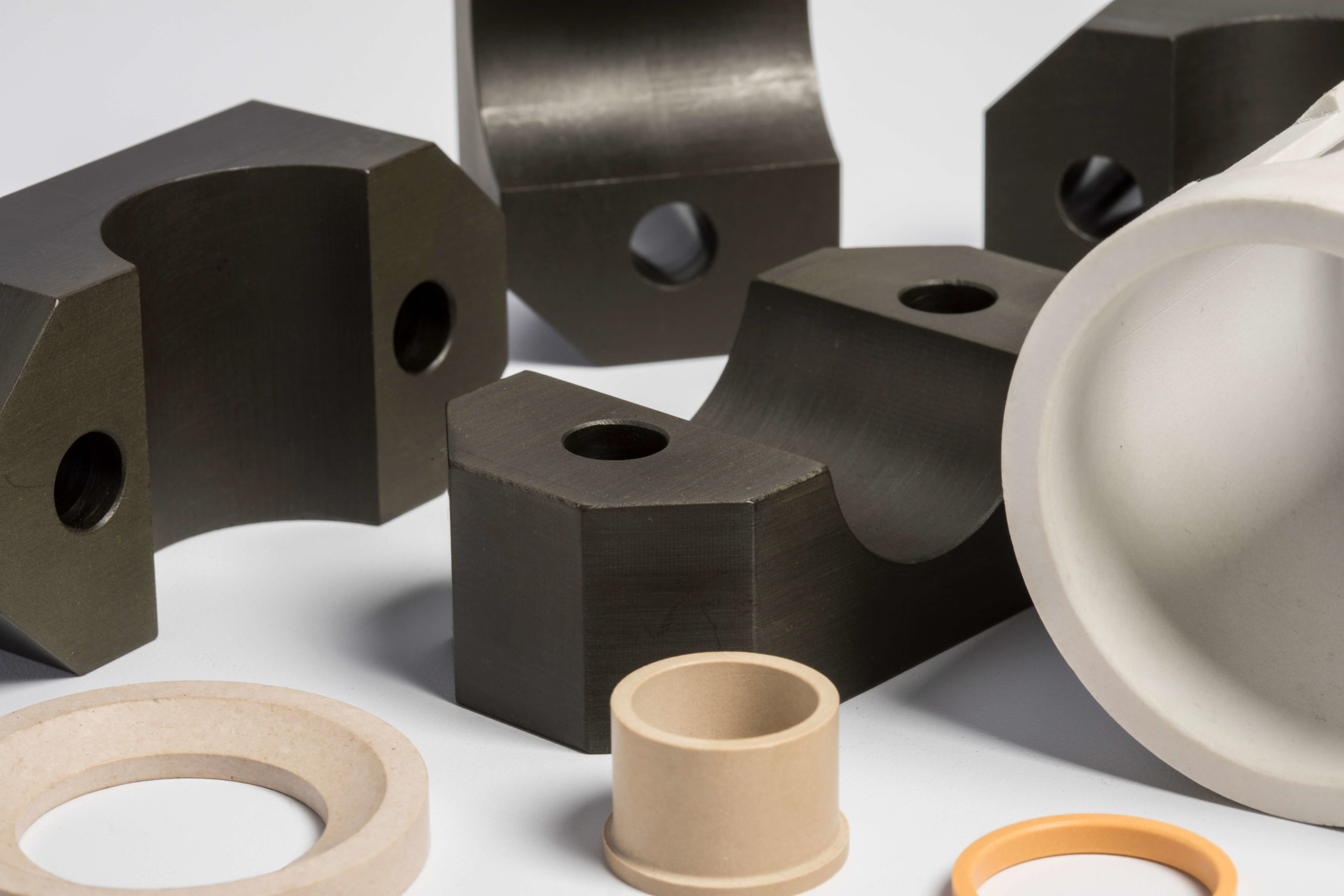Engineers often rely on bearing-grade polymers for critical aerospace applications. Bearing-grade materials, including PEEK, Torlon, and polyimide composites, are able to offer the strength and stability needed to replace metals in aerospace mechanisms.
This blog post is going to explore the defining properties, performance advantages, and design considerations of bearing-grade polymers in aerospace mechanisms.
The Engineering Challenge: Bearings in Aerospace Systems
Bearings in aerospace mechanisms face extreme operatging conditions. They must operate under high loads and speeds, withstand temperature extremes from cryogenic levels to over 500°F, and perform in vacuum or radiation environments without failure. Traditional metal bearings—though strong—can corrode, seize, or wear rapidly under these conditions. They often require lubrication, which is problematic in vacuum or high-temperature applications. Given these operating conditions, bearing-grade polymers are an attractive alternative to traditional metal bearings.
What is a Bearing-Grade Polymer?
Bearing-grade polymers are engineered plastics formulated specifically for high-performance bearing and bushing applications. Many of their enhanced properties are the result of additives such as graphite, PTFE, carbon fiber, glass, or molybdenum disulfide (MoS₂). Key parameters that define their performance include maximum pressure (P), velocity (V), and the combined PV limit, which measures load-speed endurance.
Advanced EMC’s Bearing Material Guide identifies several polymer families optimized for aerospace use, including:
- Fluorolon 3015 (PEEK BG): it has a high PV capability, good chemical resistance, and good thermal stability.
- Torlon 4435: known for its excellent high-temperature performance and low friction under high loads.
- Fluorolon 4031–4033 (Polyimide-based): exhibits outstanding thermal resistance and dry-running capabilities.
- Fluorocomp 6000/6010 (Polyimide Composites): has superior load-bearing and temperature tolerance with low wear.
Advantages of Bearing-Grade Polymers in Aerospace
Weight Reduction and Fuel Efficiency
Bearing-grade polymers are up to 80% lighter than metal counterparts. This type of weight savings directly contributes to SWaP objectives and offers much better payload and fuel efficiency.
Self-Lubrication and Maintenance-Free Operation
It is possible to obtain aerospace-grade polymers that are either naturally self-lubricating or feature built-in lubricants. This material property effectively eliminates the need for external lubrication, which is ideal for vacuum environments and reduces maintenance requirements.
Dimensional Stability and Low Thermal Expansion
Bearing-grade polymers have excellent dimensional stability and low thermal expansion. Such material properties allow them to maintain consistent clearances across a wide tempreature range. This stability prevents problems with binding or deformation that is common with metal bearings during rapid temperature shifts.
Chemical and Radiation Resistance
Polymer-grade materials include those that exhibit excellent performance even in the presence of chemicals such as hydraulic fluids, de-icing agents, fuels, and radiation without exhibiting degradation. Their chemical and radiation resistance helps ensure a long service life even in highly aggressive environments.
Vibration Damping and Noise Reduction
In addition to mechanical durability, polymers also provide vibration damping and noise attenuation. Not only can this enhance comfort but it can also reduce wear in sensitive control systems.

Common Aerospace Applications
There are a host of aerospace applications that depend on bearing-grade polymer solutions. These include ….
- Actuation Systems – Bearings in flight control, flap, and slat actuators benefit from low friction and dry-running capability.
- Landing Gear Components – Lightweight polymer bushings withstand impact loads and resist corrosion in outdoor conditions.
- Satellite and Spacecraft Mechanisms – Polyimide and PEEK bearings can perform reliably in vacuum and cryogenic environments.
- Environmental Control Systems (ECS) – Bearings resist thermal cycling in high-speed air-handling systems.
- Turbomachinery and Pumps – High-PV polymers operate effectively without lubrication in auxiliary pumps and gear mechanisms.
Comparative Overview: Bearing-Grade Polymer Families
The table below offers an overview of the most commonly used bearing-grade polymers.
| Material | Temperature Limit (°F) | Max PV (psi·ft/min) | Attributes | Typical Aerospace Use |
| Polyimide (Fluorolon 403x) | 570 | 250,000–300,000 | Low friction, high temperature, chemical resistance | Space mechanisms, dry-running bearings |
| PEEK (Fluorolon 3015) | 480 | 100,000 | High PV, chemical resistance, thermally stable | Aircraft actuators, gearboxes |
| Torlon 4435 | 500 | 100,000 | High temp, high strength, low wear | Landing gear bushings, structural bearings |
| PPS (Fluorolon 5065) | 400 | 25,000 | Low friction, moderate load | Cabin systems, auxiliary components |
| Composite (Fluorocomp 6000) | 550 | 80,000 | Polyimide-carbon composite, high load, high temp | Dry-running or high-stress joints |
Design and Integration Considerations
When designing aerospace compoents from bearing-grade polymer materials, engineers must account for issues such as creep, outgassing, and thermal expansion. Attention must also go into ensuring proper clearance, wall thickness, and housing interference, all of which are crucial to maintaining alignment and preload in the presence of fluctuating temperatures. Surface finish and counterface material also have an impact on wear performance.
Note that manufacturers such as Advanced EMC are capable of ensureing consistency through precision machining, molding, and post-processing that are in compliance with AS9100 and NASA outgassing standards.
Conclusion
Bearing-grade polymers reduce weight, extend component life, and perform where metals cannot, whether their enviroment is cryogenic vacuum conditions or at the heart of high-speed actuation systems. And as aerospace systems continue to rapidly move toward greater efficiency and autonomy, polymer bearing technology will remain a cornerstone of reliability and innovation.
Advanced EMC provides engineered polymer bearing solutions optimized for aerospace performance. Contact our knowledgeable team today to learn how high-performance materials like PEEK, Torlon, and polyimide composites can enhance your next aerospace design.


